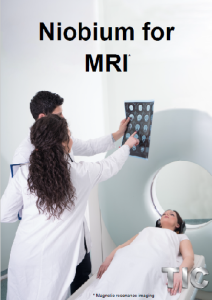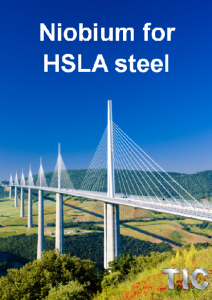the Tantalum-Niobium International Study Center (T.I.C.) : Applications for niobium : About Niobium
An international, non-profit association founded in 1974 under Belgian law.
- Metals: Niobium (Nb)
- Read 548 Times
- Metals: Niobium (Nb)
- Industries : ALL, Manufacturing, Processing, Traders
Applications for niobium
Niobium consumption is dominated by its use as additive to high strength low alloy steel and stainless steel for oil and gas pipelines, car and truck bodies, architectural requirements, tool steels, ships hulls, railroad tracks. However, there are a number of other applications for niobium metal and its compounds.
Although niobium has many applications the majority is used in the production of high-grade structural steel. The second largest application for niobium is in nickel-based superalloys.
 |
 |
 |
| Niobium Product | Application | Technical Attributes/Benefits |
|---|---|---|
| HSLA Ferroniobium (~65%Nb) | Niobium additive to high strength low alloy steel and stainless steel for oil and gas pipelines, car and truck bodies, architectural requirements, tool steels, ships hulls, railroad tracks | Imparts a doubling of strength and toughness due to grain refining. Weight reduction. |
| Niobium oxide | – Manufacture lithium niobate for surface acoustic wave filters – Camera lenses – Coating on glass for computer screens – Ceramic capacitors |
– High index of refraction – High dielectric constant – Increase light transmittance |
| Niobium carbide | Cutting tool compositions | High temperature deformation, controls grain growth |
| Niobium powder | Niobium capacitors for electronic circuits | High dielectric constant, stability of oxide dielectric |
| Niobium metal plates, sheets, wire, rod, tubing | – Sputtering targets – Cathode protection systems for large steel structures – Chemical processing equipment |
Corrosion resistance, formation of oxide and nitride films. Increase in high temperature resistance and corrosion resistance, oxidation resistance, improved creep resistance, reduced erosion at high temperatures. |
| Niobium-titanium alloy, Niobium-tin alloy | Superconducting magnetic coils in: – Magnetic resonance imagery (MRI) – Magnetoencephalography – Magnetic levitation transport systems – Particle physics experiments |
Electrical resistance of alloy wire drops to virtually zero at or below temperature of liquid helium (-268.8°C). |
| Niobium-1% zirconium alloy | – Sodium vapor lamps – Chemical processing equipment |
Corrosion resistance, fixation of oxygen, resistance to embrittlement. |
| Vacuum-grade ferro-niobium and nickel-niobium | Superalloy additions for turbine blade applications in: – Jet engines – Land-based turbines – Inconel family of alloys, superalloys |
Increase in high temperature resistance and corrosion resistance, oxidation resistance, improved creep resistance, reduced erosion at high temperatures. |
- Author: Tantalum-Niobium International Study Center (T.I.C.)
- Published Date: 10/03/2025
- The T.I.C. was established in response to concerns within the tantalum industry regarding the lack of useful information on tantalum source materials. The initial purpose of the T.I.C. was to spread information about tantalum and to promote the common interest and welfare of the producers, especially with public and private authorities, organisations and agencies. Since its foundation, the T.I.C. has grown to encompass niobium and all stages of the tantalum/niobium supply chains.
Advancing sustainability, technology, and industry collaboration since 1974.
Driving Global Innovation in Tantalum and Niobium
Connecting global innovators in tantalum and niobium, driving advancements from raw materials to cutting-edge applications.
- Supporting over 90 members across 30 countries.
- Promoting cutting-edge research and development.
- Facilitating a global network of professionals.
